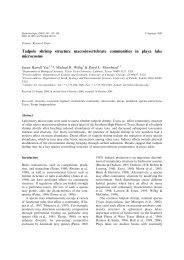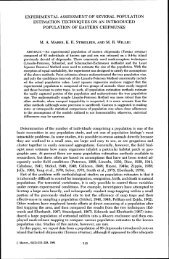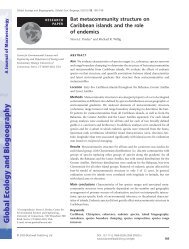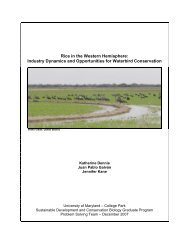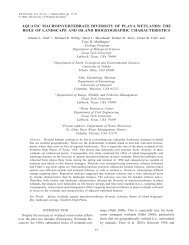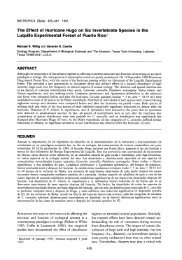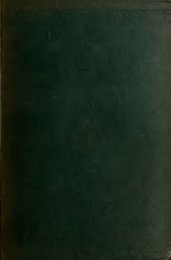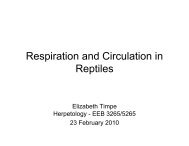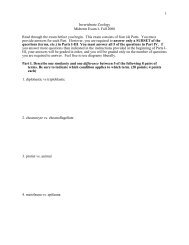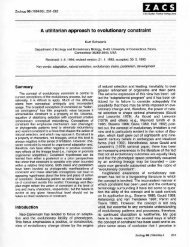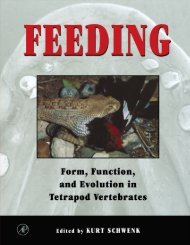Journal of Tropical Ecology (2006) - USDA Forest Service
Journal of Tropical Ecology (2006) - USDA Forest Service
Journal of Tropical Ecology (2006) - USDA Forest Service
You also want an ePaper? Increase the reach of your titles
YUMPU automatically turns print PDFs into web optimized ePapers that Google loves.
<strong>Journal</strong> <strong>of</strong> <strong>Tropical</strong> <strong>Ecology</strong> (<strong>2006</strong>) 22:111–122. Copyright © <strong>2006</strong> Cambridge University Press<br />
doi:10.1017/S0266467405002853 Printed in the United Kingdom<br />
Context-dependence <strong>of</strong> long-term responses <strong>of</strong> terrestrial gastropod<br />
populations to large-scale disturbance<br />
Christopher P. Bloch ∗1 and Michael R. Willig ∗2<br />
∗ <strong>Ecology</strong> Program, Department <strong>of</strong> Biological Sciences and The Museum, Texas Tech University, Lubbock, Texas 79409-3131, USA<br />
(Accepted 16 August 2005)<br />
Abstract: Large-scale natural disturbances, such as hurricanes, can have pr<strong>of</strong>ound effects on animal populations.<br />
Nonetheless, generalizations about the effects <strong>of</strong> disturbance are elusive, and few studies consider long-term responses<br />
<strong>of</strong> a single population or community to multiple large-scale disturbance events. In the last 20 y, two major hurricanes<br />
(Hugo and Georges) have struck the island <strong>of</strong> Puerto Rico. Long-term population trends <strong>of</strong> 17 species <strong>of</strong> terrestrial<br />
gastropod were evaluated to determine whether gastropods respond to hurricane disturbances in a consistent fashion.<br />
Some species increased, some decreased, and some exhibited no simple trend in density or spatial variability following<br />
disturbance. In addition, some species responded differently to the two hurricanes with respect to population density,<br />
absolute spatial variability, or relative spatial variability. Population responses probably hinge on trade-<strong>of</strong>fs between<br />
sensitivity to microclimatic changes and resource availability resulting from the relocation <strong>of</strong> biomass from the canopy<br />
to the forest floor. The historical context within which a hurricane occurs may be as important, or more so, than the<br />
intensity <strong>of</strong> the storm, per se.<br />
Key Words: hurricane, land snails, population dynamics, Puerto Rico<br />
INTRODUCTION<br />
Large-scale natural disturbances, such as hurricanes,<br />
can have pr<strong>of</strong>ound effects on animal populations, either<br />
directly, by causing mortality through the action <strong>of</strong> wind<br />
and rain, or indirectly, by altering the abiotic environment,habitatstructure,resourceavailability,ordensity<strong>of</strong><br />
predators or competitors. Disturbances caused by climatic<br />
events are generally unpredictable (Parmesan et al. 2000,<br />
Willig & Walker 1999), and the disturbance regime<br />
(i.e. the combination <strong>of</strong> severity, intensity, frequency,<br />
and extent <strong>of</strong> disturbances) is a dynamic characteristic<br />
unique to each ecosystem (White & Jentsch 2001).<br />
Thus, generalization about the effects <strong>of</strong> disturbance is<br />
difficult. Even within an ecosystem, disturbance events <strong>of</strong><br />
a given type (e.g. hurricanes, fires, or landslides) differ in<br />
severity,intensity,andextent(Turner&Dale1998,White<br />
1979, White & Jentsch 2001). Moreover, components<br />
<strong>of</strong> disturbance regimes may change through time (e.g.<br />
climate change may increase the frequency <strong>of</strong> intense<br />
1 Corresponding author. Email: chris.bloch@ttu.edu<br />
2 Current address: Center for Environmental Sciences and Engineering<br />
and Department <strong>of</strong> <strong>Ecology</strong> and Evolutionary Biology, 75 North<br />
Eagleville Road, University <strong>of</strong> Connecticut, Storrs, CT 06269-3043, USA<br />
hurricanes in the Atlantic Ocean and the Caribbean Sea;<br />
Goldenberg et al. 2001).<br />
Because <strong>of</strong> a variety <strong>of</strong> constraints, studies <strong>of</strong> largescale,<br />
infrequent disturbances are few relative to studies<br />
<strong>of</strong> other types <strong>of</strong> disturbance (Turner et al. 1997) and<br />
generally focus on a single disturbance event (Turner &<br />
Dale 1998). A modest number <strong>of</strong> studies has examined the<br />
effects <strong>of</strong> multiple hurricanes (Hjerpe et al. 2001, Paerl<br />
et al. 2001, Pierson et al. 1996, Schoener et al. 2004),<br />
but these rarely consider long-term responses <strong>of</strong> the same<br />
geographic population or community following multiple<br />
disturbances. Such studies are necessary because shortterm<br />
studies are snapshots that may provide misleading<br />
impressions <strong>of</strong> the general effects <strong>of</strong> disturbance (Adams<br />
2001).Theeffects<strong>of</strong>successivedisturbancescanbehighly<br />
variable (Bythell et al. 2000), and dynamics may be differentinsystemsrepeatedlyaffectedbydisturbanceevents<br />
than in those rarely subjected to disturbance (Lin et al.<br />
2003,Paineetal.1998).Acomprehensiveunderstanding<br />
<strong>of</strong> effects <strong>of</strong> disturbance requires more comparative work<br />
on disturbance events <strong>of</strong> different severity, intensity, and<br />
extent (Platt & Connell 2003, White & Jentsch 2001,<br />
Willig & Walker 1999).<br />
Terrestrial gastropods are ideal organisms with which<br />
to study the effects <strong>of</strong> disturbance, in part because they are
112 CHRISTOPHER P. BLOCH AND MICHAEL R. WILLIG<br />
taxonomically well-known and numerically abundant, as<br />
well as ecologically important, particularly with respect<br />
to nutrient cycling (Jennings & Barkham 1979, Jones &<br />
Shachak 1990, Theenhaus & Scheu 1996). In addition,<br />
gastropods are ectotherms, are susceptible to desiccation,<br />
and are not very vagile; consequently, they may be<br />
affected strongly by disturbance and its <strong>of</strong>ten substantial<br />
modification <strong>of</strong> microclimate. Despite the clear ecological<br />
importance <strong>of</strong> terrestrial gastropods, little is known about<br />
the ecology <strong>of</strong> most species. Moreover, relatively few<br />
studies directly examine the responses <strong>of</strong> terrestrial snails<br />
to natural disturbance (but see Alvarez & Willig 1993,<br />
Karlin 1961, Secrest et al. 1996, Strayer et al. 1986,<br />
Willig & Camilo 1991, Willig et al. 1998). Most studies<br />
<strong>of</strong> the effects <strong>of</strong> disturbance on animal populations<br />
have focused instead on insects or vertebrates (Willig &<br />
McGinley 1999).<br />
Although terrestrial gastropods respond to disturbance<br />
in a species-specific manner (Secrest et al. 1996, Willig &<br />
Camilo 1991, Willig et al. 1998), a few basic predictions<br />
are possible based on the biological characteristics <strong>of</strong> the<br />
group. The microclimate <strong>of</strong> canopy gaps is characterized<br />
by increased soil and air temperatures, enhanced rates <strong>of</strong><br />
evaporation, and decreased relative humidity compared<br />
with undisturbed forest (Denslow 1980, Fernandez &<br />
Fetcher 1991). The degree <strong>of</strong> microclimatic difference<br />
between disturbed and intact forest increases with the<br />
size <strong>of</strong> the gap (Lee 1978). Hot, dry conditions, such as<br />
those found in gaps, <strong>of</strong>ten affect gastropods negatively<br />
(Cook 2001, Russell-Hunter 1983). Indeed, desiccation<br />
may be the primary cause <strong>of</strong> snail mortality (Solem 1984).<br />
Eggs and early growth stages are particularly vulnerable<br />
to elevated temperatures and reduced humidity (Baur &<br />
Baur 1993, Heatwole & Heatwole 1978, Riddle 1983).<br />
Thus, hurricanes, which generate large, widespread<br />
openings in the forest canopy, should decrease population<br />
densities <strong>of</strong> terrestrial gastropods, perhaps even<br />
extirpating less abundant species from some localities.<br />
Conversely, some species (especially those most tolerant<br />
to desiccation) may benefit from conditions generated<br />
by disturbance, either by exploiting a new or increased<br />
resource base or enjoying reduced rates <strong>of</strong> predation or<br />
competition. This may be particularly true <strong>of</strong> species<br />
thathaveevolvedindisturbance-mediatedenvironments,<br />
such as the Caribbean Basin.<br />
Hurricanes produce a mosaic <strong>of</strong> environmental conditions<br />
that become less disparate over time as canopy<br />
gaps close. If the effect <strong>of</strong> hurricanes on terrestrial gastropods<br />
is primarily indirect through changes in microclimate,<br />
then population densities <strong>of</strong> snails should mirror<br />
the mosaic pattern <strong>of</strong> disturbance intensity; densities will<br />
remain relatively unaffected in undisturbed refugia and<br />
be reduced severely in the most disturbed locations. Unless<br />
disturbance is so intense as to devastate a population<br />
throughout its geographic range, variance in density<br />
should be highest after recent disturbance and decline<br />
thereafter as the canopy regenerates, microclimatic<br />
conditions become more uniform, and snail densities and<br />
distributions become less restricted by desiccation. Rare<br />
or hypodispersed species may be an exception. Reduction<br />
<strong>of</strong> their densities by disturbance may result in increased<br />
homogeneity simply because they will not be locally<br />
abundant anywhere, or because they decline at one or<br />
more <strong>of</strong> the sites where abundance is high.<br />
In the last 20 y, two major hurricanes (Hugo in 1989<br />
and Georges in 1998) have struck the island <strong>of</strong> Puerto<br />
Rico.Thetwohurricanesdifferedinintensityandseverity,<br />
with Hurricane Hugo producing larger canopy openings<br />
and depositing more debris than did Hurricane Georges<br />
(Lugo & Frangi 2003, Ostertag et al. 2003). Additionally,<br />
the historical context <strong>of</strong> the two storms differed. Hurricane<br />
Hugo was the first major hurricane to make landfall<br />
in north-eastern Puerto Rico in over 30 y (Scatena &<br />
Larsen 1991, Turner et al. 1997), whereas Hurricane<br />
Georges arrived only 9 y after Hurricane Hugo. This study<br />
evaluated long-term population-level trends <strong>of</strong> terrestrial<br />
gastropods, to determine whether species respond to<br />
hurricane disturbances in a consistent fashion, or<br />
whether differences in hurricane intensity or disturbance<br />
history result in disparate population-level responses.<br />
METHODS<br />
Study site and field methodology<br />
The Luquillo Experimental <strong>Forest</strong> (LEF) is an 11 330-ha<br />
tract <strong>of</strong> land located in the Luquillo Mountains <strong>of</strong> northeastern<br />
Puerto Rico. It ranges in elevation from 100<br />
to 1075 m and encompasses four distinct forest types:<br />
tabonuco, palo colorado, dwarf, and palm forests (Brown<br />
et al. 1983). Of these, the tabonuco forest, which is the<br />
mostextensivelystudied(Odum&Pigeon1970,Reagan&<br />
Waide 1996), is the setting for this research. This forest<br />
type occurs below 600 m and takes its name from the<br />
dominant tree, tabonuco (Dacryodes excelsa). The climate<br />
is typical <strong>of</strong> tropical forests. Rainfall is substantial (245–<br />
400 cm y –1 , depending on elevation; Brown et al. 1983),<br />
with the driest months being January through April.<br />
Relatively little seasonal or diurnal variation occurs in<br />
temperature (Odum et al. 1970).<br />
Long-term censuses <strong>of</strong> terrestrial gastropods were<br />
undertaken on the Luquillo <strong>Forest</strong> Dynamics Plot (LFDP),<br />
a 16-ha grid near El Verde Field Station, in the north-west<br />
<strong>of</strong>theLEF(18 ◦ 10 ′ N,65 ◦ 30 ′ W).Circularplots(3 mradius)<br />
were established at 40 points on the LFDP in 1991 (Willig<br />
et al. 1998). Plots were spaced evenly such that 60 m<br />
separated adjacent points along a row or column within<br />
a rectilinear grid. From 1991 to 2004, gastropod surveys<br />
were conducted twice annually to account for seasonal
Long-term responses <strong>of</strong> snails to disturbance 113<br />
variation in rainfall. The first survey each year was<br />
conducted in March (dry season) and the second during<br />
June, July or August (wet season). The lone exception<br />
was the dry season <strong>of</strong> 1999, when dry-season sampling<br />
was conducted in January rather than March to assess<br />
the effects <strong>of</strong> Hurricane Georges as soon as possible after<br />
the storm. Sampling intensity differed over time. Each<br />
plot was sampled once in the dry season <strong>of</strong> 1991, twice<br />
in each season from the wet season <strong>of</strong> 1991 to the wet<br />
season <strong>of</strong> 1993, three times per season from the dry<br />
season <strong>of</strong> 1994 to the dry season <strong>of</strong> 1995, and four<br />
times per season thereafter, except for the dry season <strong>of</strong><br />
2003 (two surveys). A minimum <strong>of</strong> 2 d was maintained<br />
between sampling periods to allow gastropods to recover<br />
from displacement during previous surveys. All surveys<br />
were conducted at night (19h30–03h00) to coincide with<br />
peak snail activity (Heatwole & Heatwole 1978, Willig<br />
et al. 1998).<br />
Each time a plot was sampled, at least two people surveyed<br />
it for a minimum <strong>of</strong> 15 min, during which time<br />
they searched for snails and slugs on all available surfaces<br />
(e.g. soil, litter, rock cover, vegetation). Searches extended<br />
upward to about 5 m from the ground. To minimize<br />
damage to long-term study sites, substrate was not manipulated<br />
in searching for specimens. All individuals were<br />
identified to species in the field and returned as closely as<br />
possible to the point <strong>of</strong> capture and always within the plot<br />
<strong>of</strong> capture.<br />
Population density <strong>of</strong> each species within each plot<br />
in each season was estimated as the mean number <strong>of</strong><br />
individuals captured per night and converted to number<br />
<strong>of</strong> individuals per ha. As it is unlikely that all individuals<br />
on a plot will be located during each survey, averaging<br />
number<strong>of</strong>capturescertainlyunderestimatestruedensity;<br />
however, it has advantages over other metrics (e.g.<br />
minimum number known alive, Lincoln–Peterson index)<br />
in that it does not require tagging <strong>of</strong> individuals, imposes<br />
few assumptions, and is not biased as a consequence<br />
<strong>of</strong> interannual differences in sampling intensity. On the<br />
other hand, visual searches inevitably are biased against<br />
detection <strong>of</strong> small species or juveniles. Mean number <strong>of</strong><br />
captures therefore provides only a relative measure <strong>of</strong><br />
density for each species and is unsuitable for comparison<br />
<strong>of</strong> density among species. Nevertheless, this relative<br />
measure <strong>of</strong> density correlates strongly with mark–recapture<br />
estimates for Caracolus caracolla, one <strong>of</strong> the largest and<br />
most conspicuous snail species on the LFDP, and Nenia<br />
tridens, a smaller, more cryptic species (Bloch 2004).<br />
Characterization <strong>of</strong> temporal trends in density<br />
Analysis <strong>of</strong> covariance (ANCOVA) was used to evaluate<br />
trends in density and spatial variation in density over<br />
time. To guard against the possibility that observed<br />
trends in variance are confounded by the correlation<br />
between means and variances, both absolute (sample<br />
variance) and relative variation (variance <strong>of</strong> log10transformed<br />
densities, which removes the correlation<br />
between mean and variance; Lande 1977, Wright<br />
1952) were considered as measures <strong>of</strong> spatial variability.<br />
Separate ANCOVAs were conducted for each species and<br />
for the total snail assemblage using SPSS version 9.0. In<br />
each analysis, the factor <strong>of</strong> interest (hurricane) indicated<br />
whether an observation came from the time period<br />
followingHurricaneHugo(1991–1998)orthatfollowing<br />
Hurricane Georges (1999–2004). The covariate was time<br />
since disturbance, measured in seasons. Thus, because<br />
the dry season <strong>of</strong> 1999 was the first sampling season<br />
following Hurricane Georges, the value <strong>of</strong> the covariate<br />
for data from this season was 1. Similarly, data collected<br />
prior to Hurricane Georges were assigned a value for time<br />
elapsed since the impact <strong>of</strong> Hurricane Hugo in 1989.<br />
Sampling began in the dry season <strong>of</strong> 1991, so a value<br />
<strong>of</strong> 3 was assigned to the covariate for data from the first<br />
sample, to indicate that two seasons had elapsed since<br />
Hurricane Hugo. Therefore, time period 3 post-Hurricane<br />
Hugo indicated the passage <strong>of</strong> the same amount <strong>of</strong><br />
time following disturbance as did time period 3 post-<br />
Hurricane Georges.<br />
Using such an analysis, it was possible to assess<br />
whether each response variable (mean density, absolute<br />
variability in density, relative variability in density)<br />
changed linearly over time, whether such a response was<br />
consistent following both hurricanes, and whether means<br />
differed between time sequences (following Hurricane<br />
Hugo versus Hurricane Georges) after accounting for<br />
the effect <strong>of</strong> time since disturbance. Significant F-tests for<br />
individual terms <strong>of</strong> an ANCOVA model were interpreted<br />
only if the overall model achieved significance (P ≤<br />
0.05). A significant interaction between hurricane and<br />
time since disturbance would indicate that the effects<br />
<strong>of</strong> hurricane identity and time since disturbance are<br />
contingent on each other; that is, the trajectory <strong>of</strong><br />
population response (i.e. slope) differs between hurricanes.<br />
If the interaction was non-significant, that<br />
term was removed from the model, the overall slope<br />
for the relationship between the response variable and<br />
time since disturbance was estimated using pooled data<br />
(Sokal & Rohlf 1995), and significant main effects were<br />
interpreted. A significant effect <strong>of</strong> time since disturbance<br />
would indicate a consistent linear response to elapsed time<br />
following a hurricane, regardless <strong>of</strong> identity. A significant<br />
effect <strong>of</strong> hurricane would imply that means differed<br />
between hurricanes, after accounting for the effect <strong>of</strong><br />
time since disturbance. These ANCOVAs assume linearity<br />
<strong>of</strong> responses to the covariate, time since disturbance. No<br />
aprioribiological reason exists, however, to presume such<br />
linearity. Therefore, an additional set <strong>of</strong> ANCOVAs was<br />
conducted, incorporating a quadratic term to model the
114 CHRISTOPHER P. BLOCH AND MICHAEL R. WILLIG<br />
association between density <strong>of</strong> each species and time since<br />
disturbance.<br />
Because we were interested primarily in the particular<br />
response <strong>of</strong> each species to disturbance, rather than overall<br />
multivariate evidence <strong>of</strong> a hurricane effect, results were<br />
interpreted without application <strong>of</strong> Bonferroni sequential<br />
adjustments (Rice 1989) to maintain experiment-wise<br />
error rate at 0.05. Recently, the use <strong>of</strong> this adjustment has<br />
engendered considerable controversy, largely because it<br />
is highly conservative, resulting in a high rate <strong>of</strong> Type II<br />
error (Hurlbert 2003, Moran 2003). The exploratory<br />
nature <strong>of</strong> this study thus argues against the use <strong>of</strong> such<br />
an adjustment (Roback & Askins 2005). Nevertheless,<br />
a Bonferroni sequential adjustment was applied to each<br />
suite <strong>of</strong> analyses and is presented for comparative<br />
purposes.<br />
RESULTS<br />
A total <strong>of</strong> 18 species <strong>of</strong> terrestrial gastropod was recorded<br />
at the study site from 1991 to 2004: Alcadia alta<br />
(Sowerby), A. striata (Lamarck), Austroselenites alticola<br />
H.B. Baker, C. caracolla (Linnaeus), C. marginella<br />
(Gmelin), Cepolis squamosa (Férussac), Gaeotis nigrolineata<br />
Shuttleworth, Lamellaxis gracilis (Hutton), Megalomastoma<br />
croceum (Gmelin), N. tridens (Schweigger),<br />
Obeliscus terebraster (Lamarck), Oleacina glabra (Pfeiffer),<br />
O. interrupta (Shuttleworth), O. playa (H.B. Baker),<br />
Platysuccinea portoricensis (Shuttleworth), Polydontes<br />
acutangula (Burrow), Subulina octona (Bruguière), and<br />
Vaginulus occidentalis (Guilding). Two species (Oleacina<br />
interrupta and O. playa) are relatively uncommon, morphologically<br />
similar, and sometimes difficult to differentiate<br />
in the field. Because it is impossible subsequently<br />
to verify identities <strong>of</strong> released and unmarked individuals,<br />
the two species are treated hereafter as a single entity and<br />
referred to as O. playa, for a total <strong>of</strong> 17 species.<br />
Patterns <strong>of</strong> population dynamics <strong>of</strong> the 17 species<br />
were heterogeneous. Indeed, each <strong>of</strong> the five possible<br />
patterns <strong>of</strong> response to disturbance that ANCOVA could<br />
reveal was represented by at least one species (Figure 1).<br />
Disturbance affected the magnitude <strong>of</strong> density or population<br />
trajectories for six <strong>of</strong> 17 species (Alcadia striata, N.<br />
tridens, O. glabra, Platysuccinea portoricensis, Polydontes<br />
acutangula and Subulina octona; Table 1). For three species,<br />
density differed between time frames: P. acutangula was<br />
more abundant from 1991 to 1998 (following Hurricane<br />
Hugo and prior to Hurricane Georges) than from 1999<br />
to 2004 (following Hurricane Georges), whereas P. portoricensis<br />
and S. octona were more abundant following<br />
Hurricane Georges. Significant linear relationships<br />
between density and time since disturbance existed for<br />
A. striata, N. tridens and P. portoricensis. Densities<br />
<strong>of</strong> N. tridens and P. portoricensis increased through<br />
time following disturbance, whereas those <strong>of</strong> A. striata<br />
declined.Thesethreeresponseswereconsistentregardless<br />
<strong>of</strong> hurricane identity (Hugo versus Georges). Densities<br />
Table 1. Results <strong>of</strong> analyses <strong>of</strong> covariance assessing temporal trends in density <strong>of</strong> terrestrial gastropod species. F-ratios and P-values indicate<br />
significance levels for terms <strong>of</strong> the model. Bold type indicates components <strong>of</strong> ANCOVA models that were significant at the 0.05 level. Individual<br />
terms <strong>of</strong> the model were interpreted only if the overall model was significant. If the interaction between time since disturbance and hurricane was<br />
non-significant, then values for all other terms and for the overall model were calculated for a model excluding the interaction. If the interaction was<br />
significant, slopes differ between hurricanes and are not reported. Degrees <strong>of</strong> freedom for models including the interaction term were 1 (interaction),<br />
1 (time since disturbance), 1 (hurricane) and 24 (error). Degrees <strong>of</strong> freedom for models excluding the interaction term were 1 (time since disturbance),<br />
1 (hurricane) and 25 (error). Bold italics indicate overall ANCOVA models that remain significant after the application <strong>of</strong> Bonferroni’s sequential<br />
adjustment.<br />
Interaction term Time since disturbance Hurricane Overall model<br />
Species F P Slope F P F P F P<br />
Alcadia alta 0.01 0.927 −1.01 1.83 0.188 3.41 0.077 1.90 0.171<br />
Alcadia striata 0.50 0.485 −5.98 9.00 0.006 1.21 0.281 4.52 0.021<br />
Austroselenites alticola 0.04 0.849 −0.07 0.02 0.881 3.79 0.063 2.49 0.103<br />
Caracolus caracolla 0.62 0.439 39.4 5.62 0.026 0.48 0.493 2.88 0.075<br />
Caracolus marginella 0.98 0.332 −1.06 3.67 0.067 3.13 0.089 2.38 0.113<br />
Cepolis squamosa 0.66 0.423 −3.21 4.83 0.038 1.52 0.229 2.46 0.106<br />
Gaeotis nigrolineata 0.00 0.974 −30.6 1.90 0.180 0.44 0.511 0.95 0.399<br />
Lamellaxis gracilis 0.91 0.350 −0.21 0.52 0.478 1.30 0.265 0.68 0.515<br />
Megalomastoma croceum 1.16 0.291 0.58 1.33 0.260 1.69 0.361 1.06 0.361<br />
Nenia tridens 2.81 0.107 109 39.9 < 0.001 3.56 0.071 32.9 < 0.001<br />
Obeliscus terebraster 2.24 0.147 0.26 2.91 0.101 1.85 0.186 1.69 0.204<br />
Oleacina glabra 4.37 0.047 – 2.73 0.111 0.40 0.535 3.53 0.030<br />
Oleacina playa∗ 0.07 0.802 0.08 0.05 0.83 0.38 0.543 0.19 0.827<br />
Platysuccinea portoricensis 0.00 0.986 4.93 12.7 0.001 25.1 < 0.001 13.8 < 0.001<br />
Polydontes acutangula 0.27 0.609 −2.52 3.84 0.061 19.1 < 0.001 9.55 < 0.001<br />
Subulina octona 2.96 0.098 0.12 0.01 0.939 9.70 0.005 5.83 0.008<br />
Vaginulus occidentalis 0.13 0.723 −0.91 3.86 0.061 0.11 0.739 2.09 0.145<br />
Total gastropods 0.25 0.622 109 11.1 0.003 1.05 0.316 9.22 0.001<br />
∗ Includes O. interrupta.
Long-term responses <strong>of</strong> snails to disturbance 115<br />
Response variable<br />
Response variable<br />
Response variable<br />
Response variable<br />
Response variable<br />
(a)<br />
(b)<br />
(c)<br />
(d)<br />
(e)<br />
Time<br />
Time<br />
Time<br />
Time<br />
Time<br />
Density (individuals/ha)<br />
Density (individuals/ha)<br />
Density (individuals/ha)<br />
Density (individuals/ha)<br />
Variance <strong>of</strong> log density<br />
3000<br />
2500<br />
2000<br />
1500<br />
1000<br />
500<br />
0<br />
200<br />
160<br />
120<br />
80<br />
40<br />
0<br />
3500<br />
3000<br />
2500<br />
2000<br />
1500<br />
1000<br />
500<br />
0<br />
250<br />
200<br />
150<br />
100<br />
50<br />
0<br />
2.5<br />
2.0<br />
1.5<br />
1.0<br />
0.5<br />
0.0<br />
Gaeotis nigrolineata<br />
1991<br />
1992<br />
1991<br />
1992<br />
1991<br />
1992<br />
1991<br />
1992<br />
1991<br />
1992<br />
1993<br />
1994<br />
1993<br />
1994<br />
1993<br />
1994<br />
1993<br />
1994<br />
1993<br />
1994<br />
1995<br />
1996<br />
1995<br />
1996<br />
1995<br />
1996<br />
1995<br />
1996<br />
1995<br />
1996<br />
1997<br />
1998<br />
Polydontes acutangula<br />
Nenia tridens<br />
Platysuccinea<br />
portoricensis<br />
Nenia tridens<br />
Figure 1. Idealized representations <strong>of</strong> possible statistical outcomes <strong>of</strong> population responses to disturbance by two hurricanes (left column), with an<br />
example <strong>of</strong> each for terrestrial gastropods on the LFDP (right column). Potential patterns are: (a) no response to disturbance (i.e. non-significant<br />
ANCOVA model), (b) mean <strong>of</strong> response variable differs between disturbances after accounting for time since disturbance (significant effect <strong>of</strong><br />
hurricane identity), (c) consistent linear response to both disturbances (significant effect <strong>of</strong> time since disturbance), (d) both b and c simultaneously,<br />
and (e) trajectory <strong>of</strong> response depends on hurricane identity (significant interaction term). Slopes and differences in magnitude <strong>of</strong> response variables<br />
between hurricanes may be positive or negative. Error bars represent 1 SE about the mean.<br />
1997<br />
1998<br />
1997<br />
1998<br />
1997<br />
1998<br />
1997<br />
1998<br />
Year<br />
1999<br />
2000<br />
1999<br />
2000<br />
1999<br />
2000<br />
1999<br />
2000<br />
1999<br />
2000<br />
2001<br />
2002<br />
2001<br />
2002<br />
2001<br />
2002<br />
2001<br />
2002<br />
2001<br />
2002<br />
2003<br />
2004<br />
2003<br />
2004<br />
2003<br />
2004<br />
2003<br />
2004<br />
2003<br />
2004
116 CHRISTOPHER P. BLOCH AND MICHAEL R. WILLIG<br />
<strong>of</strong> O. glabra, in contrast, did not respond to the two<br />
hurricanes in the same fashion (interaction term,<br />
F1,24 = 4.37, P = 0.047). Rather, densities increased<br />
more rapidly following Hurricane Georges than<br />
following Hurricane Hugo (slopes: b1 = 1.79 ±<br />
1.05 versus –0.21 ± 0.37, mean ± SE). Although<br />
significant effects <strong>of</strong> disturbance were not consistent<br />
for all species, total density <strong>of</strong> gastropods increased<br />
linearly through time following disturbance (b1 = 109,<br />
F1,25 = 11.1, P = 0.003), and the response was consistent<br />
for the two hurricanes. The effects on N. tridens, P.<br />
portoricensis and P. acutangula remained significant after<br />
application <strong>of</strong> the Bonferroni sequential adjustment.<br />
Quadratic relationships between density and time since<br />
disturbance were not prevalent. Indeed, ANCOVA models<br />
incorporating a quadratic term were significant for only<br />
three species: A. striata, C. squamosa and M. croceum.<br />
The significant quadratic term for M. croceum was driven<br />
strongly by a single datum (an unusually high density in<br />
the wet season <strong>of</strong> 1998) and probably is not indicative<br />
<strong>of</strong> a biologically meaningful trend. For A. striata and<br />
C. squamosa, on the other hand, a genuinely nonlinear<br />
response was apparent. Densities <strong>of</strong> each were greatest<br />
approximately 2 y after each hurricane and declined in a<br />
quadratic fashion thereafter (Figure 2).<br />
Similarly to mean density, absolute spatial variability<br />
in density exhibited a significant effect <strong>of</strong> disturbance<br />
(i.e. a significant ANCOVA model) for only a subset<br />
<strong>of</strong> the snail assemblage (A. striata, Caracolus marginella,<br />
N. tridens, P. portoricensis and P. acutangula; Table 2).<br />
Alcadia striata, C. marginella and P. portoricensis exhibited<br />
both a difference in variability between the two<br />
time sequences (recovery from Hurricane Hugo versus<br />
Hurricane Georges) and a consistent linear relationship<br />
betweenvariabilityandtimesincedisturbance.Polydontes<br />
acutangula displayed only the former, whereas N. tridens<br />
displayed only the latter. The interaction between<br />
hurricane identity and time since disturbance was never<br />
significant. Densities <strong>of</strong> A. striata, C. marginella and P.<br />
acutangula were more variable following Hurricane Hugo<br />
than Hurricane Georges. Platysuccinea portoricensis was<br />
the only species to exhibit greater variability in density<br />
following the second hurricane. Variabilities <strong>of</strong> densities<br />
<strong>of</strong> N. tridens and P. portoricensis increased through<br />
time following disturbance, whereas those <strong>of</strong> A. striata<br />
and C. marginella declined. For total snail abundance,<br />
disturbancehadnoapparenteffectonabsolutevariability.<br />
The effects <strong>of</strong> disturbance on three species (A. striata,<br />
N. tridens and P. portoricensis) remained significant<br />
after the application <strong>of</strong> the Bonferroni sequential<br />
adjustment.<br />
Disturbance effects were slightly more prevalent<br />
for relative variability (variance <strong>of</strong> log density) than<br />
for absolute variability; seven <strong>of</strong> 17 species displayed<br />
significant ANCOVA models, including three (N. tridens,<br />
Density (individuals/ha)<br />
Density (individuals/ha)<br />
300<br />
250<br />
200<br />
150<br />
100<br />
50<br />
0<br />
250<br />
200<br />
150<br />
100<br />
50<br />
0<br />
(a) Alcadia striata<br />
1991<br />
1991<br />
1992<br />
1992<br />
1993<br />
(b) Cepolis squamosa<br />
1993<br />
1994<br />
1994<br />
1995<br />
1995<br />
1996<br />
1996<br />
1997<br />
1997<br />
1998<br />
Year<br />
1998<br />
Year<br />
Figure 2. Population density <strong>of</strong> (a) Alcadia striata and (b) Cepolis squamosa<br />
on the Luquillo <strong>Forest</strong> Dynamics Plot from 1991 to 2004. Error bars<br />
encompass 1 SE about the mean. Dashed lines indicate the impact <strong>of</strong><br />
Hurricane Georges.<br />
P. portoricensis and P. acutangula) <strong>of</strong> the five with significant<br />
ANCOVA models for absolute variance (Table 3).<br />
Relative variability in abundance <strong>of</strong> P. acutangula<br />
was greater following Hurricane Hugo than Hurricane<br />
Georges. The converse was true <strong>of</strong> Austroselenites<br />
alticola, O. glabra, P. portoricensis and S. octona. Relative<br />
variability increased over time following disturbance<br />
for P. portoricensis. This effect was consistent for both<br />
hurricanes. GaeotisnigrolineataandN.tridensdifferedfrom<br />
other species in that relative variability in abundance<br />
responded differently to each hurricane (interaction<br />
terms F1,24 = 5.05, P = 0.033 for G. nigrolineata and<br />
F1,24 = 7.55, P = 0.011 for N. tridens). For both species,<br />
variance <strong>of</strong> density (log-transformed) decreased over time<br />
following Hurricane Hugo but not following Hurricane<br />
Georges (b1 = –0.066 ± 0.025 versus 0.038 ± 0.038<br />
for G. nigrolineata and b1 = –0.117 ± 0.022 versus<br />
–0.018 ± 0.023 for N. tridens). Relative variability <strong>of</strong> the<br />
total snail assemblage was unaffected by either hurricane<br />
identity or time since disturbance. Effects <strong>of</strong> disturbance<br />
remained significant after application <strong>of</strong> the Bonferroni<br />
1999<br />
1999<br />
2000<br />
2000<br />
2001<br />
2001<br />
2002<br />
2002<br />
2003<br />
2003<br />
2004<br />
2004
Long-term responses <strong>of</strong> snails to disturbance 117<br />
Table 2. Results <strong>of</strong> analyses <strong>of</strong> covariance assessing temporal trends in absolute variance in density <strong>of</strong> terrestrial gastropod species. F-ratios and<br />
P-values indicate significance levels for terms <strong>of</strong> the model. Bold type indicates components <strong>of</strong> ANCOVA models that were significant at the 0.05<br />
level. Individual terms <strong>of</strong> the model were interpreted only if the overall model was significant. In all cases, the interaction between time since<br />
disturbance and hurricane was non-significant; therefore, values for all other terms and for the overall model were calculated for a model excluding<br />
the interaction. Degrees <strong>of</strong> freedom were 1 (time since disturbance), 1 (hurricane) and 25 (error). Bold italics indicate overall ANCOVA models<br />
that remain significant after the application <strong>of</strong> Bonferroni’s sequential adjustment.<br />
Time since disturbance Hurricane Overall model<br />
Species Slope F P F P F P<br />
Alcadia alta −136 0.12 0.727 1.72 0.201 0.89 0.423<br />
Alcadia striata −2295 15.4 0.001 7.56 0.011 8.40 0.002<br />
Austroselenites alticola −101 0.98 0.331 0.45 0.510 1.23 0.310<br />
Caracolus caracolla 41969 1.10 0.305 0.31 0.586 1.16 0.329<br />
Caracolus marginella −423 5.83 0.023 5.56 0.027 3.98 0.031<br />
Cepolis squamosa −3509 3.69 0.066 3.66 0.067 2.57 0.096<br />
Gaeotis nigrolineata −149552 1.82 0.190 0.03 0.868 1.25 0.303<br />
Lamellaxis gracilis −265 2.63 0.117 2.22 0.148 1.70 0.203<br />
Megalomastoma croceum 688 2.21 0.150 0.37 0.551 1.11 0.347<br />
Nenia tridens 235652 26.9 < 0.001 0.01 0.947 16.3 < 0.001<br />
Obeliscus terebraster 15 0.55 0.464 0.65 0.429 0.42 0.661<br />
Oleacina glabra −35 0.22 0.645 0.38 0.545 0.52 0.603<br />
Oleacina playa∗ −17 0.05 0.822 0.14 0.716 0.16 0.854<br />
Platysuccinea portoricensis 2519 9.51 0.005 11.5 0.002 7.37 0.003<br />
Polydontes acutangula −1299 3.46 0.075 14.0 0.001 7.02 0.004<br />
Subulina octona −2936 0.59 0.451 2.01 0.169 2.16 0.136<br />
Vaginulus occidentalis −319 3.34 0.080 1.39 0.249 1.77 0.192<br />
Total gastropods<br />
∗ Includes O. interrupta.<br />
244843 3.60 0.070 0.01 0.942 2.14 0.139<br />
Table 3. Results <strong>of</strong> analyses <strong>of</strong> covariance assessing temporal trends in relative variance in density (i.e. variance <strong>of</strong> log density) <strong>of</strong> terrestrial gastropod<br />
species. F-ratios and P-values indicate significance levels for terms <strong>of</strong> the model. Bold type indicates components <strong>of</strong> ANCOVA models that were<br />
significant at the 0.05 level. Individual terms <strong>of</strong> the model were interpreted only if the overall model was significant. If the interaction between time<br />
since disturbance and hurricane was non-significant, then values for all other terms and for the overall model were calculated for a model excluding<br />
the interaction. If the interaction was significant, slopes differ between hurricanes and are not reported. Degrees <strong>of</strong> freedom for models including<br />
the interaction term were 1 (interaction), 1 (time since disturbance), 1 (hurricane) and 24 (error). Degrees <strong>of</strong> freedom for models excluding the<br />
interaction term were 1 (time since disturbance), 1 (hurricane) and 25 (error). Bold italics indicate overall ANCOVA models that remain significant<br />
after the application <strong>of</strong> Bonferroni’s sequential adjustment.<br />
Interaction term Time since disturbance Hurricane Overall model<br />
Species F P Slope F P F P F P<br />
Alcadia alta 0.05 0.825 −0.02 3.32 0.081 2.54 0.123 2.06 0.148<br />
Alcadia striata 0.42 0.523 −0.03 6.00 0.022 1.85 0.186 3.06 0.065<br />
Austroselenites alticola 0.08 0.775 0.00 0.14 0.712 8.98 0.006 5.00 0.015<br />
Caracolus caracolla 0.68 0.418 −0.03 4.68 0.040 4.65 0.041 3.26 0.055<br />
Caracolus marginella 0.56 0.462 −0.01 1.31 0.264 0.74 0.398 0.74 0.489<br />
Cepolis squamosa 0.05 0.829 −0.01 1.05 0.315 0.02 0.886 0.58 0.568<br />
Gaeotis nigrolineata 5.15 0.033 – 0.37 0.547 7.72 0.010 3.00 0.050<br />
Lamellaxis gracilis 3.80 0.063 0.00 0.01 0.907 0.30 0.587 0.23 0.797<br />
Megalomastoma croceum 0.75 0.395 0.01 0.57 0.458 4.42 0.046 2.22 0.129<br />
Nenia tridens 7.55 0.011 – 14.2 0.001 1.45 0.241 21.4 < 0.001<br />
Obeliscus terebraster 2.68 0.115 0.01 4.02 0.056 2.39 0.134 2.30 0.121<br />
Oleacina glabra 3.43 0.076 0.02 1.98 0.172 7.66 0.010 3.86 0.035<br />
Oleacina playa∗ 0.06 0.803 0.01 0.57 0.456 1.12 0.300 0.62 0.548<br />
Platysuccinea portoricensis 2.01 0.169 0.06 22.0 < 0.001 35.1 < 0.001 20.4 < 0.001<br />
Polydontes acutangula 0.29 0.597 −0.02 2.78 0.108 15.7 0.001 7.84 0.002<br />
Subulina octona 3.20 0.086 0.01 0.90 0.352 21.8 < 0.001 11.6 < 0.001<br />
Vaginulus occidentalis 1.68 0.208 −0.02 3.34 0.079 0.32 0.579 2.79 0.081<br />
Total gastropods 2.74 0.111 −0.03 4.82 0.038 2.65 0.116 2.69 0.087<br />
∗ Includes O. interrupta.
118 CHRISTOPHER P. BLOCH AND MICHAEL R. WILLIG<br />
sequential adjustment for four species (N. tridens, P.<br />
portoricensis, P. acutangula and S. octona).<br />
DISCUSSION<br />
Although previous studies have documented effects <strong>of</strong><br />
disturbance on terrestrial gastropod populations, this<br />
study represents the longest regularly sampled assemblage<br />
examined in this context. Time since disturbance<br />
for a variety <strong>of</strong> disturbance types (i.e. agriculture, fire<br />
or logging) had no effect on density <strong>of</strong> any species <strong>of</strong><br />
gastropod in New England forests, but the small size <strong>of</strong><br />
disturbed patches and their proximity to undisturbed<br />
forest probably accounted for a rapid return to predisturbance<br />
densities (Strayer et al. 1986). Elsewhere,<br />
abundance <strong>of</strong> snails typically decreases following fire<br />
(Karlin 1961) and logging (Hylander et al. 2004). Recovery<br />
<strong>of</strong> populations occurs over a period <strong>of</strong> years to<br />
decades. Young stands <strong>of</strong> conifers harbour low numbers<br />
<strong>of</strong> gastropods relative to old growth forests (Shikov 1984),<br />
but as regenerating forests enter later successional stages,<br />
densities <strong>of</strong> gastropods can exceed those in old growth<br />
(Ström 2004). Similarly, some gastropod species in the<br />
LEF exceeded pre-disturbance densities within 5 y after<br />
Hurricane Hugo (Secrest et al. 1996, Willig et al. 1998)<br />
despite large initial declines (Willig & Camilo 1991).<br />
The most directly comparable results to the present<br />
study are those <strong>of</strong> Willig and colleagues (Alvarez & Willig<br />
1993, Secrest et al. 1996, Willig & Camilo 1991, Willig<br />
et al. 1998), who used similar sampling techniques to<br />
examine the effects <strong>of</strong> natural disturbance on terrestrial<br />
gastropods in the LEF prior to Hurricane Georges. These<br />
studies clearly demonstrated that early responses <strong>of</strong><br />
gastropod populations can differ among disturbance types<br />
(i.e. hurricanes vs. individual treefalls). Current results<br />
extend this finding, suggesting that long-term responses<br />
also may differ among disturbance events <strong>of</strong> the same type<br />
(i.e. Hurricanes Hugo vs. Georges).<br />
Nenia tridens represents an example <strong>of</strong> contextdependent<br />
responses to disturbance. This species was low<br />
in density following both hurricanes, and increased in<br />
density over time following disturbance, suggesting that<br />
initial environmental conditions produced by hurricanes<br />
are inhospitable. In contrast, prior to Hurricane Hugo,<br />
density <strong>of</strong> N. tridens was greater in treefall gaps than<br />
in undisturbed forest, suggesting that N. tridens could<br />
exploit resources available in gaps (i.e. dead plant<br />
material and the algae and fungi that grow on it;<br />
Alvarez & Willig 1993, J. de Jesus, pers. comm.) without<br />
experiencing severe desiccation (Alvarez & Willig 1993).<br />
At that time, however, over 30 y had passed since the<br />
last major hurricane (Scatena & Larsen 1991, Turner<br />
et al. 1997). In tabonuco forest that had not recently<br />
experienced a major hurricane, treefall gaps may have<br />
been too small or topographically heterogeneous to develop<br />
extreme environmental differences from undisturbed<br />
forest (Alvarez & Willig 1993). The effect <strong>of</strong> a<br />
hurricane covers a greater area and produces many gaps<br />
comprising multiple treefalls, and may therefore produce<br />
more noticeable or different effects. Patterns <strong>of</strong> succession<br />
<strong>of</strong> trees, for example, differ between open patches created<br />
by hurricanes and gaps resulting from individual treefalls;<br />
pioneer species may be more important in treefall gaps<br />
than in patches generated by hurricanes (Vandermeer<br />
et al. 2000).<br />
Although Hurricane Hugo initially caused precipitous<br />
declines in population densities <strong>of</strong> terrestrial gastropods<br />
(Willig & Camilo 1991), a variety <strong>of</strong> species-specific<br />
population trajectories developed in subsequent years<br />
(Willig et al. 1998). No evidence in the present study<br />
contradicts these findings. Some species increased in<br />
density over time following disturbance, whereas others<br />
declined. Many species, in contrast, displayed no clear<br />
linear or quadratic response to disturbance. More<br />
interesting, perhaps, are differences in the effects <strong>of</strong><br />
the two hurricanes. Post-hurricane density or spatial<br />
variability <strong>of</strong> several species differed after Hurricane Hugo<br />
(from 1991 to 1998) compared with after Hurricane<br />
Georges (1999 to 2004). Moreover, patterns <strong>of</strong> change<br />
in population size or relative spatial variability <strong>of</strong> three<br />
species differed between the two hurricanes.<br />
The creation <strong>of</strong> canopy openings by hurricanes has<br />
two major effects: deposition <strong>of</strong> organic matter on the<br />
forest floor and modification <strong>of</strong> microclimate. An obvious<br />
trade-<strong>of</strong>f exists between these two effects; a hurricane<br />
that deposits more material on the forest floor will<br />
necessarily have a greater effect on microclimate, as<br />
a function <strong>of</strong> the larger size or wider distribution <strong>of</strong><br />
canopy openings. Both hurricanes, therefore, increased<br />
the resource base for terrestrial gastropods (e.g. litter and<br />
debris, either directly or as a substrate for algae, fungi,<br />
and other microbes; Heatwole & Heatwole 1978), while<br />
simultaneously producing unfavourable microclimatic<br />
conditions. Although Hurricane Georges deposited less<br />
debris than did Hurricane Hugo (Lugo & Frangi 2003,<br />
Ostertag et al. 2003), it also produced less extensive<br />
openings in the canopy (M.R. Willig et al., unpubl.<br />
data), which required less recovery time before canopy<br />
closure and the restoration <strong>of</strong> initial microclimatic<br />
conditions. Different responses <strong>of</strong> different species (or <strong>of</strong><br />
a single species among disturbance types or particular<br />
hurricanes) probably hinge on the relative sensitivities <strong>of</strong><br />
species to microclimate, habitat structure, and resource<br />
availability. Alcadia striata and C. squamosa may be<br />
prime examples. Both species appear to respond in<br />
lagged fashion. Immediately following a hurricane, when<br />
environmental conditions are most extreme, they exhibit<br />
low densities. Within 2 y, densities peak, perhaps because<br />
conditions have ameliorated sufficiently to allow these
Long-term responses <strong>of</strong> snails to disturbance 119<br />
species to exploit increased resource availability. Changing<br />
conditions (e.g. degradation <strong>of</strong> resources, alteration <strong>of</strong><br />
microclimate, interspecific interactions) may conspire to<br />
limit the ability <strong>of</strong> A. striata and C. squamosa to maintain<br />
high densities thereafter.<br />
Within a group as diverse as the Gastropoda, different<br />
species probably would be adapted differentially<br />
to conditions created by hurricanes. This variety <strong>of</strong><br />
responses is not limited to snails. Tree species exhibit<br />
considerable differences in the degree <strong>of</strong> damage they<br />
suffer from hurricanes and their ability to recover<br />
thereafter (Zimmerman et al. 1994). Responses <strong>of</strong> spiders<br />
to Hurricane Hugo depended strongly on locations <strong>of</strong><br />
webs: species that build webs close to the ground,<br />
anchoring to dead leaves or debris, increased in density,<br />
whereas those that attach webs to living leaves declined<br />
(Pfeiffer 1996). For birds and bats, effects <strong>of</strong> hurricanes<br />
were more pronounced for frugivores and nectarivores<br />
than for other groups (Jones et al. 2001, Waide 1991).<br />
Insect species may be driven locally extinct (Schowalter<br />
1994, Willig & Camilo 1991), or they may undergo<br />
outbreaks in response to resource pulses (Torres 1992).<br />
Disturbance types differ in extent, frequency or intensity<br />
(Walker & Willig 1999, White & Pickett 1985),<br />
or in degree <strong>of</strong> resultant landscape heterogeneity (Turner<br />
et al. 1997). Less frequently acknowledged, though, is the<br />
distribution<strong>of</strong>extentsandintensitieswithinadisturbance<br />
type. Nevertheless, even disturbances with wide-ranging<br />
effects, such as hurricanes, differ in severity. Differences in<br />
wind speed and amount <strong>of</strong> rainfall obviously influence the<br />
severity <strong>of</strong> damage caused by a storm (Tanner et al. 1991).<br />
The trajectory <strong>of</strong> the storm also can be important. For<br />
example, Hurricane Hugo passed over only the eastern<br />
third <strong>of</strong> Puerto Rico (Scatena & Larsen 1991), whereas<br />
Hurricane Georges devastated the entire island. The<br />
Jamaican fruit bat, Artibeus jamaicensis, suffered declines<br />
in density following both hurricanes (Gannon & Willig<br />
1994, Jones et al. 2001, Rodríguez-Durán & Vázquez<br />
2001) but recovered more rapidly following Hurricane<br />
Hugo, at least in part because <strong>of</strong> immigration from undisturbed<br />
parts <strong>of</strong> the island, which were less common<br />
following Hurricane Georges (Rodríguez-Durán &<br />
Vázquez 2001).<br />
Historicalfactorscanmodifytheeffects<strong>of</strong>adisturbance.<br />
Catastrophic disturbance by windstorms removes large<br />
numbers <strong>of</strong> mature canopy trees, thus reducing rates<br />
<strong>of</strong> canopy gap formation by treefalls as the dead trees<br />
are replaced by smaller individuals, which are unlikely<br />
to senesce in the short term (Whigham et al. 1999).<br />
Thus, older forests generally suffer greater damage than<br />
do younger ones (Grove et al. 2000, Lomascolo & Aide<br />
2001), because older, taller trees are more likely to be<br />
damaged by wind (Brokaw 1985, Runkle 1985). Before<br />
Hurricane Hugo struck Puerto Rico in 1989, over 30 y<br />
had passed since the previous major hurricane (Scatena &<br />
Larsen 1991, Turner et al. 1997), whereas only 9 y<br />
elapsed between Hurricane Hugo and Hurricane Georges.<br />
Thus, the smaller, younger forest probably sustained less<br />
damage than would have transpired had the landfall<br />
<strong>of</strong> Hurricane Georges occurred in 1989. Alternatively,<br />
repeated disturbance can exacerbate effects on native<br />
species. Cyclones striking in consecutive years reduced<br />
resources so much that the flying fox, Pteropus tonganus,<br />
declinedtolessthan0.1%<strong>of</strong>pre-cyclonedensities(Pierson<br />
et al. 1996).<br />
In addition, the variety <strong>of</strong> responses observed for<br />
gastropods may in part reflect the influence <strong>of</strong> other<br />
disturbance types during the 15-y study. For example,<br />
a period <strong>of</strong> high rainfall that caused extreme flooding in<br />
March <strong>of</strong> 1998 may be partly responsible for a decline in<br />
some species (e.g. Nenia tridens; see Figure 1c) even before<br />
the arrival <strong>of</strong> Hurricane Georges. Although treefall gaps,<br />
landslides, and, to a lesser extent, flash floods are localized<br />
in their effects, droughts <strong>of</strong>ten influence ecosystem and<br />
community dynamics throughout the LEF (Burrowes<br />
et al. 2004, Covich et al. 2003, Schowalter & Ganio 2003).<br />
In an extreme drought, activity <strong>of</strong> terrestrial gastropods<br />
undoubtedly is reduced and mortality increased. Such<br />
signals may be evident for some gastropod species (e.g. a<br />
pronounced decrease in density <strong>of</strong> G. nigrolineata in 1994,<br />
a drought year; see Figure 1a), but the extent to which<br />
their effects persist and interact with those <strong>of</strong> hurricanes<br />
remains unclear.<br />
Clearly, historical contingencies and differences between<br />
disturbance events can result in heterogeneous<br />
responses <strong>of</strong> species. In this context, there is little wonder<br />
that some snail species responded differently to Hurricane<br />
Hugo than to Hurricane Georges. In future studies <strong>of</strong><br />
large-scale disturbance, researchers should avoid the<br />
implicit assumption that all hurricanes are equal in<br />
severity or equivalent with respect to the trajectory <strong>of</strong><br />
recovery that follows them. The historical context within<br />
which a storm occurs may be as important, if not more<br />
so, than the intensity <strong>of</strong> the storm, per se.<br />
ACKNOWLEDGEMENTS<br />
This research was supported by grants BSR-8811902,<br />
DEB 9411973, DEB 0080538 and DEB 0218039 from<br />
NSF to the Institute for <strong>Tropical</strong> Ecosystem Studies,<br />
University <strong>of</strong> Puerto Rico, and to the International<br />
Institute <strong>of</strong> <strong>Tropical</strong> <strong>Forest</strong>ry, <strong>USDA</strong> <strong>Forest</strong> <strong>Service</strong>, as<br />
part <strong>of</strong> the Long-Term Ecological Research Program<br />
in the Luquillo Experimental <strong>Forest</strong>. The <strong>USDA</strong> <strong>Forest</strong><br />
<strong>Service</strong>, US Department <strong>of</strong> Energy, and the University <strong>of</strong><br />
Puerto Rico provided additional support. CPB received<br />
additional support from the Department <strong>of</strong> Biological<br />
Sciences at Texas Tech University and the Texas Tech<br />
University Association <strong>of</strong> Biologists. Stephen Cox, Richard
120 CHRISTOPHER P. BLOCH AND MICHAEL R. WILLIG<br />
Deslippe, Mark McGinley, Richard Strauss, John Zak and<br />
three anonymous reviewers provided helpful suggestions<br />
for improving this manuscript. Voucher specimens are<br />
housed at the Academy <strong>of</strong> Natural Sciences, Philadelphia,<br />
PA, USA. Finally, we thank the staff <strong>of</strong> El Verde Field<br />
Station and the many students and colleagues who<br />
assisted with field work over the years.<br />
LITERATURE CITED<br />
ADAMS, A. 2001. Effects <strong>of</strong> a hurricane on two assemblages <strong>of</strong> coral<br />
reef fishes: multiple-year analysis reverses a false ‘snapshot’ interpretation.<br />
Bulletin <strong>of</strong> Marine Science 69:341–356.<br />
ALVAREZ, J. & WILLIG, M. R. 1993. Effects <strong>of</strong> treefall gaps on the<br />
density <strong>of</strong> land snails in the Luquillo Experimental <strong>Forest</strong>. Biotropica<br />
25:100–110.<br />
BAUR, B. & BAUR, A. 1993. Climatic warming due to thermal-radiation<br />
from an urban area as possible cause for the local extinction <strong>of</strong> a land<br />
snail. <strong>Journal</strong> <strong>of</strong> Applied <strong>Ecology</strong> 30:333–340.<br />
BLOCH, C. P. 2004. Long-term responses <strong>of</strong> snail populations and<br />
communities to disturbance in the Luquillo Experimental <strong>Forest</strong>, Puerto<br />
Rico.Ph.D.Dissertation.TexasTechUniversity,Lubbock,Texas,USA.<br />
BROKAW, N. V. L. 1985. Treefalls, regrowth, and community structure<br />
in tropical forests. Pp. 53–69 in Pickett, S. T. A. & White, P. S. (eds.).<br />
The ecology <strong>of</strong> natural disturbance and patch dynamics. Academic Press,<br />
San Diego.<br />
BROWN, S., LUGO, A. E., SILANDER, S. & LIEGEL, L. 1983. Research<br />
history and opportunities in the Luquillo Experimental <strong>Forest</strong>. United<br />
States Department <strong>of</strong> Agriculture, <strong>Forest</strong> <strong>Service</strong>, Southern <strong>Forest</strong><br />
Experiment Station, New Orleans, Louisiana, USA.<br />
BURROWES, P. A., JOGLAR, R. L. & GREEN, D. E. 2004. Potential causes<br />
for amphibian declines in Puerto Rico. Herpetologica 60:141–154.<br />
BYTHELL, J. C., HILLIS-STARR, Z. M. & ROGERS, C. S. 2000. Local<br />
variability but landscape stability in coral reef communities following<br />
repeated hurricane impacts. Marine <strong>Ecology</strong> Progress Series 204:93–<br />
100.<br />
COOK, A. 2001. Behavioural ecology: on doing the right thing, in the<br />
right place at the right time. Pp. 447–487 in Barker, G. M. (ed.). The<br />
biology <strong>of</strong> terrestrial molluscs. CAB International, Wallingford.<br />
COVICH, A. P., CROWL, T. A. & SCATENA, F. N. 2003. Effects <strong>of</strong> extreme<br />
low flows on freshwater shrimps in a perennial tropical stream.<br />
Freshwater Biology 48:1199–1206.<br />
DENSLOW, J. S. 1980. Gap partitioning among tropical rainforest trees.<br />
Biotropica 12:47–55.<br />
FERNANDEZ, D. S. & FETCHER, N. 1991. Changes in light availability<br />
following Hurricane Hugo in a subtropical montane forest in Puerto<br />
Rico. Biotropica 23:393–399.<br />
GANNON, M. R. & WILLIG, M. R. 1994. Effects <strong>of</strong> Hurricane Hugo on<br />
bats <strong>of</strong> the Luquillo Experimental <strong>Forest</strong> <strong>of</strong> Puerto Rico. Biotropica<br />
26:320–331.<br />
GOLDENBERG, S. B., LANDSEA, C. W., MESTAS-NUÑEZ, A. M. & GRAY,<br />
W. M. 2001. The recent increase in Atlantic hurricane activity:<br />
causes and implications. Science 293:474–479.<br />
GROVE, S. J., TURTON, S. M. & SIEGENTHALER, D. T. 2000. Mosaics <strong>of</strong><br />
canopy openness induced by tropical cyclones in lowland rain forests<br />
with contrasting management histories in northeastern Australia.<br />
<strong>Journal</strong> <strong>of</strong> <strong>Tropical</strong> <strong>Ecology</strong> 16:883–894.<br />
HEATWOLE, H. & HEATWOLE, A. 1978. <strong>Ecology</strong> <strong>of</strong> the Puerto Rican<br />
camaenid tree-snails. Malacologia 17:241–315.<br />
HJERPE, J., HEDENÁS, H. & ELMQVIST, T. 2001. <strong>Tropical</strong> rain forest<br />
recovery from cyclone damage and fire in Samoa. Biotropica 33:249–<br />
259.<br />
HURLBERT, S. H. 2003. Design and analysis: uncertain intent,<br />
uncertain result. <strong>Ecology</strong> 84:810–812.<br />
HYLANDER,K.,NILSSON,C.&GÖTHNER,T.2004.Effects<strong>of</strong>buffer-strip<br />
retention and clearcutting on land snails in boreal riparian forests.<br />
Conservation Biology 18:1052–1062.<br />
JENNINGS, T. J. & BARKHAM, J. P. 1979. Litter decomposition by slugs<br />
in mixed deciduous woodland. Holarctic <strong>Ecology</strong> 2:21–29.<br />
JONES, C. G. & SHACHAK, M. 1990. Fertilization <strong>of</strong> the desert soil by<br />
rock-eating snails. Nature 346:839–841.<br />
JONES, K. E., BARLOW, K. E., VAUGHAN, N., RODRÍGUEZ-DURÁN, A. &<br />
GANNON,M.R.2001.Short-termimpacts<strong>of</strong>extremeenvironmental<br />
disturbance on the bats <strong>of</strong> Puerto Rico. Animal Conservation 4:59–66.<br />
KARLIN, E. J. 1961. Ecological relationships between vegetation and<br />
the distribution <strong>of</strong> land snails in Montana, Colorado and New Mexico.<br />
American Midland Naturalist 65:60–66.<br />
LANDE, R. 1977. On comparing coefficients <strong>of</strong> variation. Systematic<br />
Zoology 26:214–217.<br />
LEE, R. 1978. <strong>Forest</strong> microclimatology. Columbia University Press,<br />
New York. 276 pp.<br />
LIN, K., HAMBURG, S. P., TANG, S., HSIA, Y. & LIN, T. 2003. Typhoon<br />
effects on litterfall in a subtropical forest. Canadian <strong>Journal</strong> <strong>of</strong> <strong>Forest</strong><br />
Research 33:2184–2192.<br />
LOMASCOLO, T. & AIDE, T. M. 2001. Seed and seedling bank dynamics<br />
in secondary forests following Hurricane Georges in Puerto Rico.<br />
Caribbean <strong>Journal</strong> <strong>of</strong> Science 37:259–270.<br />
LUGO, A. E. & FRANGI, J. L. 2003. Changes in necromass and nutrients<br />
ontheforestfloor<strong>of</strong>apalmfloodplainforestintheLuquilloMountains<br />
<strong>of</strong> Puerto Rico. Caribbean <strong>Journal</strong> <strong>of</strong> Science 39:265–272.<br />
MORAN, M. D. 2003. Arguments for rejecting the sequential Bonferroni<br />
in ecological studies. Oikos 100:403–405.<br />
ODUM, H. T. & PIGEON, R. F. (eds.) 1970. A tropical rain forest: a study<br />
<strong>of</strong> irradiation and ecology at El Verde, Puerto Rico. U.S. Atomic Energy<br />
Commission, Oak Ridge.<br />
ODUM, H. T., DREWRY, G. & KLINE, J. R. 1970. Climate at El Verde,<br />
1963–1966. Pp. B347–B418 in Odum, H. T. & Pigeon, R. F. (eds.).<br />
A tropical rain forest: a study <strong>of</strong> irradiation and ecology at El Verde, Puerto<br />
Rico. U.S. Atomic Energy Commission, Oak Ridge.<br />
OSTERTAG, R., SCATENA, F. N. & SILVER, W. L. 2003. <strong>Forest</strong> floor<br />
decomposition following hurricane litter inputs in several Puerto<br />
Rican forests. Ecosystems 6:261–273.<br />
PAERL, H. W., BALES, J. D., AUSLEY, L. W., BUZZELLI, C. P., CROWDER,<br />
L. B., EBY, L. A., FEAR, J. M., GO, M., PEIERLS, B. L., RICHARDSON,<br />
T. L. & RAMUS, J. S. 2001. Ecosystem impacts <strong>of</strong> three sequential<br />
hurricanes (Dennis, Floyd, and Irene) on the United States’ largest<br />
lagoonal estuary, Pamlico Sound, NC. Proceedings <strong>of</strong> the National<br />
Academy <strong>of</strong> Sciences <strong>of</strong> the USA 98:5655–5660.
Long-term responses <strong>of</strong> snails to disturbance 121<br />
PAINE, R. T., TEGNER, M. J. & JOHNSON, E. A. 1998. Compounded<br />
perturbations yield ecological surprises. Ecosystems 1:535–<br />
545.<br />
PARMESAN, C., ROOT, T. L. & WILLIG, M. R. 2000. Impacts <strong>of</strong> extreme<br />
weather and climate on terrestrial biota. Bulletin <strong>of</strong> the American<br />
Meteorological Society 81:443–450.<br />
PFEIFFER, W. J. 1996. Arboreal arachnids. Pp. 247–271 in Reagan,<br />
D. P. & Waide, R. B. (eds.). The food web <strong>of</strong> a tropical rain forest. University<br />
<strong>of</strong> Chicago Press, Chicago.<br />
PIERSON, E. D., ELMQVIST, T., RAINEY, W. E. & COX, P. A. 1996.<br />
Effects <strong>of</strong> tropical cyclonic storms on flying fox populations on the<br />
South Pacific islands <strong>of</strong> Samoa. Conservation Biology 10:438–451.<br />
PLATT, W. J. & CONNELL, J. H. 2003. Natural disturbances and<br />
directional replacement <strong>of</strong> species. Ecological Monographs 73:507–<br />
522.<br />
REAGAN, D. P. & WAIDE, R. B. (eds.) 1996. The food web <strong>of</strong> a tropical rain<br />
forest. University <strong>of</strong> Chicago Press, Chicago. 616 pp.<br />
RICE, W. R. 1989. Analyzing tables <strong>of</strong> statistical tests. Evolution 43:223–<br />
225.<br />
RIDDLE, W. A. 1983. Physiological ecology <strong>of</strong> land snails and slugs.<br />
Pp. 431–461 in Russell-Hunter, W. D. (ed.). The Mollusca. Volume 6,<br />
ecology. Academic Press, Orlando.<br />
ROBACK, P. J. & ASKINS, R. A. 2005. Judicious use <strong>of</strong> multiple<br />
hypothesis tests. Conservation Biology 19:261–267.<br />
RODRÍGUEZ-DURÁN, A. & VÁZQUEZ, R. 2001. The bat Artibeus<br />
jamaicensis in Puerto Rico (West Indies): seasonality <strong>of</strong> diet, activity,<br />
and effect <strong>of</strong> a hurricane. Acta Chiropterologica 3:53–61.<br />
RUNKLE, J. R. 1985. Disturbance regimes in temperate forests. Pp. 17–<br />
33 in Pickett, S. T. A. & White, P. S. (eds.), The ecology <strong>of</strong> natural<br />
disturbance and patch dynamics. Academic Press, San Diego.<br />
RUSSELL-HUNTER, W. D. 1983. Overview: planetary distribution <strong>of</strong><br />
and ecological constraints upon the Mollusca. Pp.1–27 in Russell-<br />
Hunter,W.D.(ed.),The Mollusca. Volume 6, ecology. Academic Press,<br />
Orlando.<br />
SCATENA, F. N. & LARSEN, M. C. 1991. Physical aspects <strong>of</strong> Hurricane<br />
Hugo in Puerto Rico. Biotropica 23:317–323.<br />
SCHOENER, T. W., SPILLER, D. A. & LOSOS, J. B. 2004. Variable<br />
ecological effects <strong>of</strong> hurricanes: the importance <strong>of</strong> seasonal timing<br />
for survival <strong>of</strong> lizards on Bahamian islands. Proceedings <strong>of</strong> the National<br />
Academy <strong>of</strong> Sciences <strong>of</strong> the USA 101:177–181.<br />
SCHOWALTER, T. D. 1994. Invertebrate community structure and<br />
herbivory in a tropical rainforest canopy in Puerto Rico following<br />
Hurricane Hugo. Biotropica 26:312–319.<br />
SCHOWALTER, T. D. & GANIO, L. M. 2003. Diel, seasonal and<br />
disturbance-induced variation in invertebrate assemblages. Pp. 315–<br />
328 in Basset, Y., Novotny, V., Miller, S. E. & Kitching, R. (eds.).<br />
Arthropods <strong>of</strong> tropical forests: spatio-temporal dynamics and resource use<br />
in the canopy. Cambridge University Press, Cambridge.<br />
SECREST, M. F., WILLIG, M. R. & PEPPERS, L. L. 1996. The legacy <strong>of</strong><br />
disturbance on habitat associations <strong>of</strong> terrestrial snails in the Luquillo<br />
Experimental <strong>Forest</strong>, Puerto Rico. Biotropica 28:502–514.<br />
SHIKOV, E. V. 1984. Effects <strong>of</strong> land use changes on the land mollusc<br />
fauna in the central portion <strong>of</strong> the Russian plain. Pp. 237–248<br />
in Solem, A. & van Bruggen, A. C. (eds.). World-wide snails:<br />
biogeographical studies on non-marine Mollusca. E.J. Brill, Leiden.<br />
SOKAL, R. R. & ROHLF, F. J. 1995. Biometry: the principles and practice<br />
<strong>of</strong> statistics in biological research. W. H. Freeman and Company,<br />
New York. 887 pp.<br />
SOLEM, A. 1984. A world model <strong>of</strong> land snail diversity and abundance.<br />
Pp. 6–22 in Solem, A. & van Bruggen, A. C. (eds.). World-wide<br />
snails: biogeographical studies on non-marine Mollusca. E. J. Brill,<br />
Leiden.<br />
STRAYER, D., PLETSCHER, D. H., HAMBURG, S. P. & NODVIN,<br />
S. C. 1986. The effects <strong>of</strong> forest disturbance on land gastropod<br />
communities in northern New England. Canadian <strong>Journal</strong> <strong>of</strong> Zoology<br />
64:2094–2098.<br />
STRÖM, L. 2004. Long-term effects <strong>of</strong> riparian clear-cutting – richer land<br />
snail communities in regenerating forests. M.S. Thesis, Ume˚a University,<br />
Sweden.<br />
TANNER, E. V. J., KAPOS, V. & HEALEY, J. R. 1991. Hurricane<br />
effects on forest ecosystems in the Caribbean. Biotropica 23:513–<br />
521.<br />
THEENHAUS, A. & SCHEU, S. 1996. The influence <strong>of</strong> slug (Arion rufus)<br />
mucus and cast material addition on microbial biomass, respiration,<br />
and nutrient cycling in beech leaf litter. Biology and Fertility <strong>of</strong> Soils<br />
23:80–85.<br />
TORRES, J. A. 1992. Lepidoptera outbreaks in response to successional<br />
changes after the passage <strong>of</strong> Hurricane Hugo in Puerto Rico. <strong>Journal</strong><br />
<strong>of</strong> <strong>Tropical</strong> <strong>Ecology</strong> 8:285–298.<br />
TURNER, M. G. & DALE, V. H. 1998. Comparing large, infrequent<br />
disturbances: what have we learned? Ecosystems 1:493–<br />
496.<br />
TURNER, M. G., DALE, V. H. & EVERHAM, E. H. 1997. Fires, hurricanes,<br />
and volcanoes: comparing large disturbances. BioScience 47:758–<br />
768.<br />
VANDERMEER, J., DE LA CERDA, I. G., BOUCHER, D., PERFECTO, I. &<br />
RUÍZ, J. 2000. Hurricane disturbance and tropical tree species<br />
diversity. Science 290:788–791.<br />
WAIDE, R. B. 1991. The effect <strong>of</strong> Hurricane Hugo on bird populations<br />
in the Luquillo Experimental <strong>Forest</strong>, Puerto Rico. Biotropica 23:475–<br />
480.<br />
WALKER, L. R. & WILLIG, M. R. 1999. An introduction to terrestrial<br />
disturbances. Pp. 1–16 in Walker, L. R. (ed.). Ecosystems <strong>of</strong> disturbed<br />
ground. Elsevier Press, Amsterdam.<br />
WHIGHAM, D. F., DICKINSON, M. B. & BROKAW, N. V. L. 1999.<br />
Background canopy gap and catastrophic wind disturbances in<br />
tropical forests. Pp. 223–252 in Walker, L. R. (ed.). Ecosystems <strong>of</strong><br />
disturbed ground. Elsevier Press, Amsterdam.<br />
WHITE, P. S. 1979. Pattern, process, and natural disturbance in<br />
vegetation. The Botanical Review 45:229–299.<br />
WHITE, P. S. & JENTSCH, A. 2001. The search for generality in studies<br />
<strong>of</strong> disturbance and ecosystem dynamics. Progress in Botany 62:399–<br />
449.<br />
WHITE, P. S. & PICKETT, S. T. A. 1985. Natural disturbance and patch<br />
dynamics: an introduction. Pp. 3–13 in Pickett, S. T. A. & White, P. S.<br />
(eds.). The ecology <strong>of</strong> natural disturbance and patch dynamics. Academic<br />
Press, San Diego.<br />
WILLIG, M. R. & CAMILO, G. R. 1991. The effect <strong>of</strong> Hurricane Hugo on<br />
six invertebrate species in the Luquillo Experimental <strong>Forest</strong> <strong>of</strong> Puerto<br />
Rico. Biotropica 23:455–461.
122 CHRISTOPHER P. BLOCH AND MICHAEL R. WILLIG<br />
WILLIG, M. R. & MCGINLEY, M. A. 1999. The response <strong>of</strong> animals<br />
to disturbance and their roles in patch generation. Pp. 633–657<br />
in Walker, L. R. (ed.). Ecosystems <strong>of</strong> disturbed ground. Elsevier Press,<br />
Amsterdam.<br />
WILLIG, M. R. & WALKER, L. R. 1999. Disturbance in terrestrial<br />
ecosystems: salient themes, synthesis, and future directions. Pp.747–<br />
767 in Walker, L. R. (ed.). Ecosystems <strong>of</strong> disturbed ground. Elsevier<br />
Press, Amsterdam.<br />
WILLIG, M. R., SECREST, M. F., COX, S. B., CAMILO, G. R.,<br />
CARY, J. F., ALVAREZ, J. & GANNON, M. R. 1998. Longterm<br />
monitoring <strong>of</strong> snails in the Luquillo Experimental <strong>Forest</strong><br />
<strong>of</strong> Puerto Rico: heterogeneity, scale, disturbance, and recovery.<br />
Pp. 293–322 in Dallmeier, F. & Comisky, J. (eds.). <strong>Forest</strong><br />
biodiversity in North, Central, and South America and the Caribbean:<br />
research and monitoring. UNESCO and The Parthenon Press,<br />
Carnforth.<br />
WRIGHT, S. 1952. The genetics <strong>of</strong> quantitative variability. Pp. 5–41 in<br />
Reeve, E. C. R. & Weddington, C. H. (eds.). Quantitative inheritance.<br />
Her Majesty’s Stationery Office, London.<br />
ZIMMERMAN, J. K., EVERHAM, E. M., WAIDE, R. B., LODGE, D. J.,<br />
TAYLOR, C. M. & BROKAW, N. V. L. 1994. Responses <strong>of</strong> tree species<br />
to hurricane winds in subtropical wet forest in Puerto Rico: implications<br />
for tropical tree life histories. <strong>Journal</strong> <strong>of</strong> <strong>Ecology</strong> 82:911–<br />
922.



